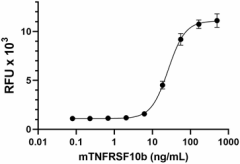- Regulatory Status
- RUO
- Other Names
- Tumor necrosis factor receptor superfamily member 10B (TNFRSF10B), TNF-related apoptosis-inducing ligand receptor 2 (TRAIL R2), TRAIL receptor 2, Death receptor 5 (DR5), CD262, KILLER, TRICK2

-

Recombinant mouse TNFRSF10b inhibits human TRAIL-mediated cytotoxicity (measured by Deep Blue Cell Viability™ Kit) on L929 cells, in the presence of 12 ng/mL cross-linked human TRAIL and 1 µg/mL Actinomycin D. The ED50 for this effect is 10 – 50 ng/mL. -

Mouse TNFRSF10B was aliquoted in PBS, pH 7.0 at 0.1 mg/ml and one aliquot was kept at 4°C (control), and another was freeze/thawed four times (4X freeze/thaws). After this procedure, the samples were tested for their ability to inhibit the cytotoxic effect induced by recombinant human TRAIL on mouse L929 cells.
| Cat # | Size | Price | Quantity Check Availability | ||
|---|---|---|---|---|---|
| 768706 | 100 µg | $382.00 | |||
TNFRSF10B, also called TRAIL R2 and DR5, is a member of the TNF receptor superfamily. It contains a cysteine-rich extracellular domain, a transmembrane domain and an intracellular death domain, which mediates interactions between death receptor and death domain-containing adaptor proteins. When the trimeric ligand TRAIL (TNFSF10) is bound, homotrimer TNFRSF10B interacts with the adaptor protein Fas-associated death domain (FADD), in turn recruits caspase-8 and assembles a death-inducing signaling complex (DISC) that initiates apoptosis. There are decoy receptors, TRAIL R3 (DcR1), TRAIL R4 (DcR2), and OPG, which antagonize the apoptotic effect via competitive ligand binding. Several evidences indicated that TNFRSF10B play roles in tumorigenesis, immune response, and DNA damage response. Some studies have suggested that TNFRSF10B contributes more than TNFRSF10A (TRAIL R1) to TRAIL-induced apoptosis in cancer cells that express both receptors. In addition, agonistic monoclonal antibodies against TNFRSF10B, which can induce apoptosis in the absence of TRAIL, are used for cancer therapies. Loss of TNFRSF10B promotes lymphomagenesis and metastasis. Squamous cell carcinoma of the head and the neck may be caused by the mutation of TNFRSF10B. Recent study demonstrated that TNFRSF10B associates with CD40 and negatively regulates CD40L-induced NF-κB activation and proliferation in primary human B cells. The expression of TNFRSF10B is inducible and up-regulated by DNA damage in p53-dependent manner. The TNFRSF10B deficiency mice showed decreased survival after exposure to ionizing radiation. In human, there are three isoforms produced by alternative splicing.
Product Details
- Source
- Mouse TNFRSF10B, amino acid (Asn53-Ser177) (Accession: # BC065141), with a linker (GSSR) and a C-terminal human IgG (Pro100-Lys330), was expressed in 293E cells.
- Molecular Mass
- The 360 amino acid recombinant protein has a predicted molecular mass of approximately 40 kD. The DTT-reduced and non-reduced protein migrates at approximately 52 and 97 kD respectively by SDS-PAGE. The predicted N-terminal amino acid is Asn.
- Purity
- > 95%, as determined by Coomassie stained SDS-PAGE.
- Formulation
- 0.22 µm filtered protein solution is in 1x PBS.
- Endotoxin Level
- Less than 0.1 EU per µg cytokine as determined by the LAL method.
- Concentration
- 10 and 25 µg sizes are bottled at 200 µg/mL. 100 µg size and larger sizes are lot-specific and bottled at the concentration indicated on the vial. To obtain lot-specific concentration and expiration, please enter the lot number in our Certificate of Analysis online tool.
- Storage & Handling
- Unopened vial can be stored between 2°C and 8°C for up to 2 weeks, at -20°C for up to six months, or at -70°C or colder until the expiration date. For maximum results, quick spin vial prior to opening. The protein can be aliquoted and stored at -20°C or colder. Stock solutions can also be prepared at 50 - 100 µg/mL in appropriate sterile buffer, carrier protein such as 0.2 - 1% BSA or HSA can be added when preparing the stock solution. Aliquots can be stored between 2°C and 8°C for up to one week and stored at -20°C or colder for up to 3 months. Avoid repeated freeze/thaw cycles.
- Activity
- Recombinant mouse TNFRSF10b inhibits human TRAIL-mediated cytotoxicity (measured by Deep Blue Cell Viability™ Kit) on L929 cells, in the presence of 12 ng/mL cross-linked human TRAIL and 1 µg/mL Actinomycin D. The ED50 for this effect is 10 – 50 ng/mL.
- Application
-
Bioassay
- Application Notes
-
BioLegend carrier-free recombinant proteins provided in liquid format are shipped on blue-ice. Our comparison testing data indicates that when handled and stored as recommended, the liquid format has equal or better stability and shelf-life compared to commercially available lyophilized proteins after reconstitution. Our liquid proteins are verified in-house to maintain activity after shipping on blue ice and are backed by our 100% satisfaction guarantee. If you have any concerns, contact us at tech@biolegend.com.
Antigen Details
- Structure
- Homodimer, disulfide bond-linked
- Distribution
-
Membrane; heart, lung, kidney, intestine, bladder, mammary gland, ovary, placenta.
- Function
- TNFRSF10B play roles in tumorigenesis, immune response, and DNA damage response. TNFRSF10B induces apoptosis upon the binding of the ligand TNFSF10.
- Interaction
- TRADD
- Ligand/Receptor
- TRAIL (TNFSF10)
- Biology Area
- Apoptosis/Tumor Suppressors/Cell Death
- Molecular Family
- Cytokine/Chemokine Receptors, Soluble Receptors
- Antigen References
-
- Walczak H, et al. 1997. EMBO J. 16:5386.
- Ashkenazi A. 2002. Nat. Rev. Cancer 2:420.
- LeBlanc HN, et al. 2003. Cell Death Differ. 10:66.
- Kelley RF, et al. 2005. J. Biol. Chem. 280:2205.
- Johnstone RW, et al. 2008. Nat. Rev. Cancer. 8:782.
- Wu GS, et al. 1997. Nat. Genet. 17:1413.
- Wu GS, et al. 1999. Cancer Res. 59:2770-5.
- Pai SI, et al. 1998. Cancer Res. 58:3513.
- Finnberg N, et al. 2008. J. Clin. Invest. 118:111.
- Grosse-Wilde A, et al. 2008. J. Clin. Invest. 118:100.
- Finnberg N, et al. 2005. Mol. Cell. Biol. 25:2000.
- Smulski CR, et al. 2017. Cell Death and Dis. 8:e2601.
- Gene ID
- 21933 View all products for this Gene ID
- UniProt
- View information about TNFRSF10B on UniProt.org
